PHYLLIS HASTINGS
A BIBLIOGRAPHY
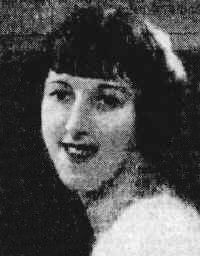
Phyllis Hastings (1904-1994)
Novels | Short Stories | Nonfiction Books
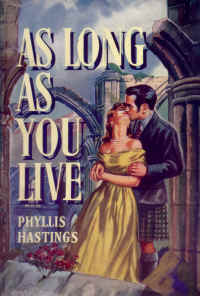
As Long As You Live
Published by Herbert Jenkins, 1951
Compelling reading, this was Hastings's first novel. It tells the darkly ironic story of
the Grackle family, who are trying to keep a certain relative alive so she can reach her
hundredth birthday. Great-grandmother, having become a centenarian with a very particular
insurance policy, would then inherit a fortune!
Crowning Glory
Published by Herbert Jenkins, 1952
Receiving rave reviews at the time of its publication, Crowning Glory is an
amusing story about a hairdresser in Mayfair, London who invents a lotion that would make
any woman's hair everlastingly beautiful with just one application.
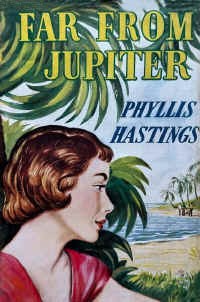
Far from Jupiter
Published by Herbert Jenkins, 1952
This wonderful novel is an enchanting tale of one woman and six men on a Pacific Island.
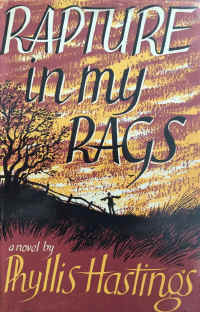
Rapture in My Rags
Published by J. M. Dent & Sons, 1954
The inspiration for Rapture in My Rags came from Walter de la Mare's poem,
"The Scarecrow", which he kindly allowed to be printed at the beginning of the
book.
This novel was reprinted in the USA by Popular Library in 1954 under the title Rapture
and again in 1955 as A Time for Pleasure. It was later reprinted in the UK in
1960 by Pan Books under the title Scarecrow Lover.
Rapture in My Rags was adapted by screenwriter Stanley Mann into the 1965 feature
film Rapture, which was made by Twentieth Century Fox and directed by John
Guillermin. There was also a Persian language adaptation of this novel which was filmed in
Iran. The screenplay was written by Mehdi Nourbakhsh and the movie released in 2004 under
the title Ashegh-e matarsak.
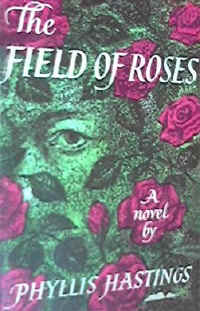
The Field of Roses
Published by J. M. Dent & Sons, 1955
This novel was reprinted in the USA by E. P. Dutton & Co. in 1956 under the title Her
French Husband.

Dust is My Pillow
Published by J. M. Dent & Sons, 1955
This novel was reprinted in the USA by Popular Library in 1956 under the title The
Innocent and the Wicked.
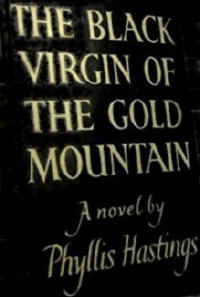
The Black Virgin of the Gold Mountain
Published by J. M. Dent & Sons, 1956
This novel, set within a rather primitive community in the Auvergne region of France, is
about a local peasant girl and a visiting English artist. MGM bought the film rights to The
Black Virgin of the Gold Mountain before the noted English film director, Carol Reed,
subsequently acquired the adaptation rights for himself. Whether the movie was made and
released under a new title, or not at all, remains a mystery, although I believe Reed's
project never got off the ground.
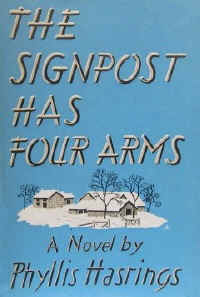
The Signpost Has Four Arms
Published by J. M. Dent & Sons, 1957
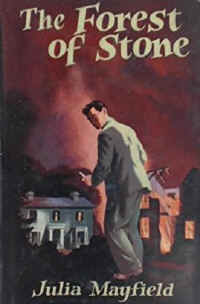
The Forest of Stone
Published by Robert Hale, 1957
This novel was printed under the pseudonym Julia Mayfield.
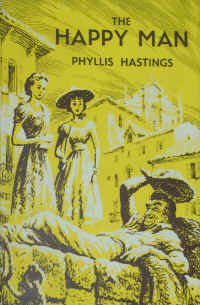
The Happy Man
Published by Hutchinson, 1958
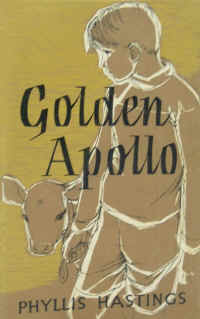
Golden Apollo
Published by Hutchinson, 1958
This is a beautifully written novel for all ages about a young boy who lives on a farm and
his mission to save a Jersey calf, which he sees as a friend, from the abattoir. Golden
Apollo inspired members of the Bristol Vegetarian Society who had read it to invite
Phyllis Hastings back to her home city and give a speech, which she entitled "The
Quality of Mercy", at a public meeting of the organisation held at Royal Hotel,
College Green on June 27, 1959.
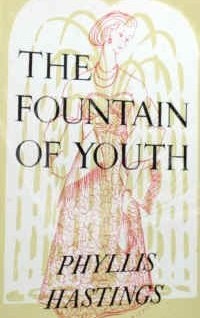
The Fountain of Youth
Published by Hutchinson, 1959
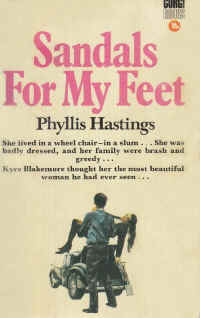
Sandals for My Feet
Published by Hutchinson, 1960
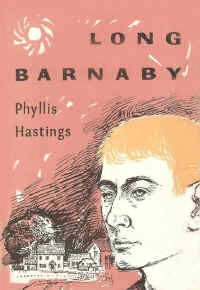
Long Barnaby
Published by Hodder & Stoughton, 1961
This novel was reprinted by May Fair Books in 1962 under the title Hot Day in High
Summer. Long Barnaby was intended to be made into a television drama series
in 1962, with the screenplay already written by director and producer Leslie Norman. There
were plans for the location filming of this adaptation to take place in the countryside
near Hastings's home in Mayfield, East Sussex. However, I have been unable, so far, to
find out anything more with regards to the episode broadcast dates or which British
television channel it may have aired on. With no information available on The Internet
Movie Database, I suspect that this series was never made. I would be happy to be proved
wrong if anyone reading this has any information to share.

The Night the Roof Blew Off
Published by Hodder & Stoughton, 1962

Their Flowers Were Always Black
Published by Robert Hale, 1967
This novel was reprinted by New English Library in 1969 under the title The Harlot's
Daughter.
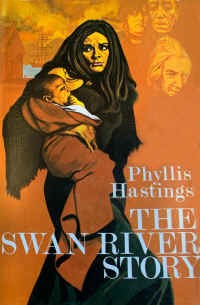
The Swan River Story
Published by Robert Hale, 1968
Australia is the setting for this outstanding tale about a young governess who leaves
Victorian England to start a new life.
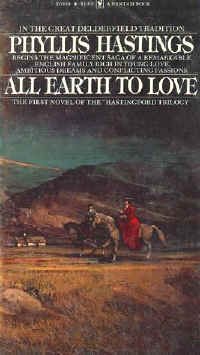
All Earth to Love
Published by Corgi Books, 1968
This is the first novel in The Hastingford Trilogy, a pastoral saga that chronicles the
lives of the Dyke family, who run a farm in Sussex. All Earth to Love is set in
the 19th century, during the reign of George III.
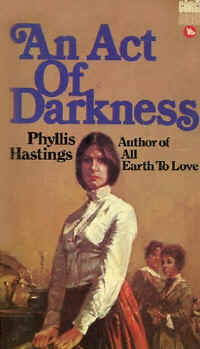
An Act of Darkness
Published by Robert Hale, 1969
This novel was reprinted in the USA by G. P. Putnam's Sons in 1970 under the title The
House on Malador Street.

The Stars Are My Children
Published by Robert Hale, 1970
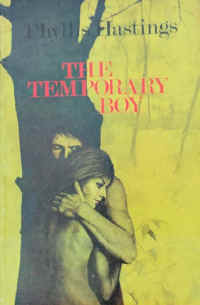
The Temporary Boy
Published by Robert Hale, 1971

When the Gallows is High
Published by Robert Hale, 1971
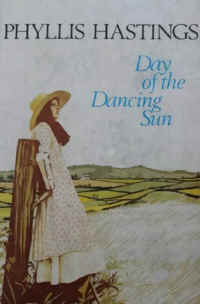
Day of the Dancing Sun
Published by Corgi Books, 1971
This is the second novel in The Hastingford Trilogy, a pastoral saga that chronicles the
lives of the Dyke family, who run a farm in Sussex. Day of the Dancing Sun is set
in the year 1800.
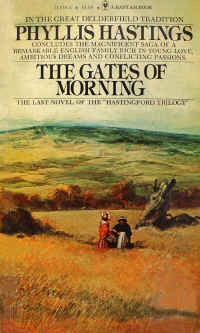
The Gates of Morning
Published by Corgi Books, 1973
This is the third novel in The Hastingford Trilogy, a pastoral saga that chronicles the
lives of four generations of the Dyke family, who run a farm in Sussex. In 1974, The
Gates of Morning won the Elizabeth Goudge Historical Award, which was presented to
the author by the Romantic Novelists' Association on the occasion of their annual dinner
at the Park Lane Hotel in London.
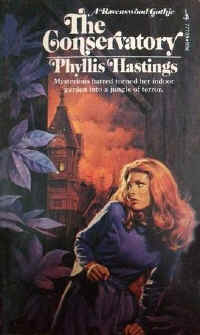
The Conservatory
Published by Robert Hale, 1973
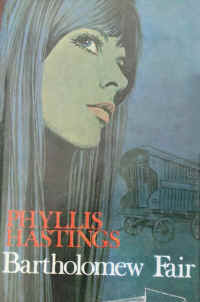
Bartholomew Fair
Published by Robert Hale, 1974
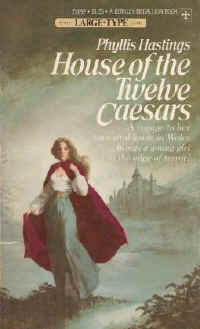
House of the Twelve Caesars
Published by Robert Hale, 1975

The Image-Maker
Published by Robert Hale, 1976
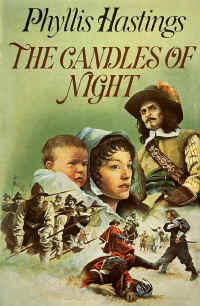
The Candles of Night
Published by Cassell, 1977
Set in the 17th century at the time of the English Civil War and the Restoration of the
Stuart monarchy, this is the first novel in the London Quartet series, which tells the
story of the Quilter family across several generations.
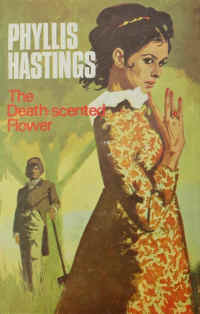
The Death-Scented Flower
Published by Robert Hale, 1977

Field of the Forty Footsteps
Published by Robert Hale, 1978
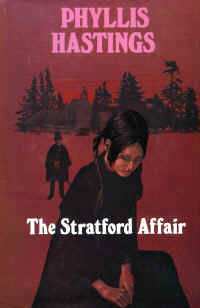
The Stratford Affair
Published by Robert Hale, 1978

The Feast of the Peacock
Published by Cassell, 1978
Set in the 18th century, at the time of Bonnie Prince Charlie's invasion and the threat of
the French fleet in the English Channel, this is the second novel in the London Quartet
series, which tells the story of the Quilter family across several generations.
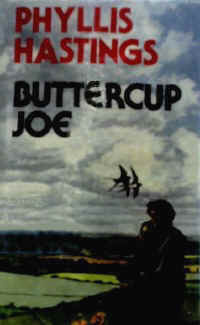
Buttercup Joe
Published by Robert Hale, 1980

Running Thursday
Published by Robert Hale, 1980

Tiger's Heaven
Published by Robert Hale, 1981
A Delight of Angels
Published by Robert Hale, 1981
This novel, which is set in the mid-19th century, is almost certainly the third book in
the London Quartet series, which tells the story of the Quilter family across several
generations. At the time of writing, I have been unable to track down a copy of this
elusive book!
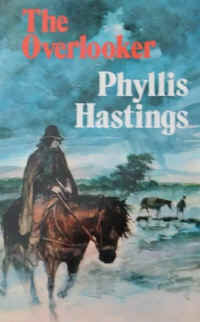
The Overlooker
Published by Robert Hale, 1982
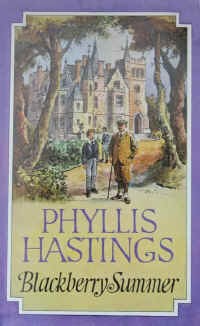
Blackberry Summer
Published by Robert Hale, 1982
The Lion at the Door
Published by Robert Hale, 1983
Set in the early 20th century, with much of the action taking place in an Oxford Street
department store, this is the fourth novel in the London Quartet series, which tells the
story of the Quilter family across several generations. I have yet to identify the third
book in this series, although I believe that to be A Delight of Angels.
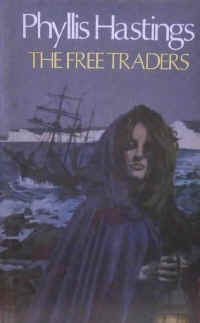
The Free Traders
Published by Robert Hale, 1984

My Four Uncles
Published by Robert Hale, 1984

The Women Barbers of Drury Lane
Published by Robert Hale, 1985
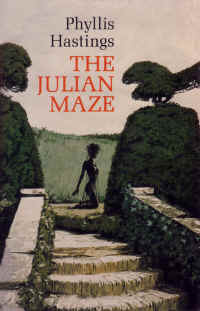
The Julian Maze
Published by Robert Hale, 1986
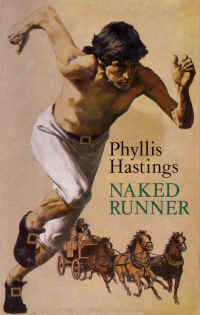
Naked Runner
Published by Robert Hale, 1987
"Apple-Core"
The Saturday Review, April 14, 1934
"Public Enemy"
The Evening Standard, March 5, 1935
The Evening Despatch (Birmingham), July 20, 1935
"Black Ivory"
The Evening News, May 6, 1935
"Mr. Pendleberry's Peccadillo"
The Evening News, June 7, 1935
"The Admiral Hits the Deck"
The Daily Herald, June 22, 1935
The Mercury (Hobart, Tasmania), September 4, 1935
The Auckland Star (New Zealand), March 16, 1936 (this short story is reprinted
here under the title "The Admiral Hit the Deck")
"Funeral March for One"
The Evening News, July 9, 1935
"The Normans Lived in Castles!"
The Evening News, July 13, 1935
"Definitely!"
The Evening News, August 2, 1935
"Nightingale Valley"
The Evening News, September 3, 1935
"The Dean Will Be Dining on Thursday"
Woman's Magazine, October 1935
"Scene of the Crime"
The 20-Story Magazine, October 1935
"Two of a Kind"
The Evening News, October 3, 1935
"Overdoing It!"
The Daily Mail, October 5, 1935
"Yesterday's Eagle"
The Evening News, October 9, 1935
"Little Darling"
The Daily Mirror, November 16, 1935
"Farewell Performance"
The Evening News, December 12, 1935
" 'A Little Bit of Heaven' "
The Evening News, February 27, 1936
"Black Prodigal"
The Daily Mirror, March 14, 1936
"Legs for the Force"
The Evening News, March 30, 1936
"The Lion Breed"
The Daily Mail, April 3, 1936
"Chinese Red"
The Evening News, April 25, 1936
"Every Tuesday Night"
The 20-Story Magazine, May 1936
"Castle in Spain"
The 20-Story Magazine, August 1936
"Second Rate"
The Daily Mirror, August 6, 1936
"Ambition in Andorra"
The Evening News, August 12, 1936
"Bolero"
The Daily Mirror, September 19, 1936
This short story was very topical at the time of its publication because it was set in
Spain during the Civil War.
"The Camels Have Come"
The Evening News, October 24, 1936
"The Well of Fantasy"
The Daily Herald, October 27, 1936
The Telegraph (Brisbane, Queensland, Australia), February 13, 1937
The Auckland Star (New Zealand), February 19, 1937
The Argus (Melbourne, Victoria, Australia), September 23, 1937
The Daily News (Perth, Western Australia), November 9, 1937
"Gopak"
The Evening News, November 27, 1936
"He Who Travels with Women"
The 20-Story Magazine, December 1936
"Christmas Rose"
Weldon's Ladies' Journal, No. 690, December 1936
"Laugh and the World ..."
The Daily Mirror, December 24, 1936
"Enchanted Valley"
The Daily Mail, January 5, 1937
"Mrs. Skeggs's Century"
The 20-Story Magazine, March 1937
"Red Wine Was Spilt"
The Daily Mirror, March 8, 1937
This is the first short story in Hastings's Ivan of the Imperial series, which is set in
the Court of the Tsar shortly before the Russian Revolution of 1917.
"Mother Vodka"
The Daily Mirror, March 9, 1937
This is the second short story in Hastings's Ivan of the Imperial series.
"Curdled Milk"
The Daily Mirror, March 10, 1937
This is the third short story in Hastings's Ivan of the Imperial series.
"Coffee for One"
The Daily Mirror, March 11, 1937
This is the fourth short story in Hastings' Ivan of the Imperial series.
"Russian Tea"
The Daily Mirror, March 12, 1937
This is the fifth short story in Hastings's Ivan of the Imperial series.
"Water is Sweet"
The Daily Mirror, March 13, 1937
This is the sixth and final short story in Hastings's Ivan of the Imperial series.
"The House on the Golden Mountain"
The 20-Story Magazine, May 1937
"To Henry—With Love"
The Daily Mirror, May 10, 1937
"Passing of a Swan"
The Daily Mail, May 29, 1937
"Personality Pays"
The Daily Mirror, August 17, 1937
"Off With the Motley"
The Evening News, October 9, 1937
The South Wales Evening Post, December 27, 1937
The Herald (Melbourne, Victoria, Australia), March 19, 1938
"The Mandarin Bed"
The Evening News, May 23, 1938
"To Him Who Waits"
The Evening News, October 17, 1938
"Olde English"
The 20-Story Magazine, February 1939
"Money Is a Burden"
The 20-Story Magazine, April 1939
"Mr. Bastipole Prefers Bacchus"
The Birmingham Weekly Post, April 1939 (issue date unknown)
"Smith Four"
The Birmingham Weekly Post, July 1939 (issue date unknown)
"Something About an Old Love"
The 20-Story Magazine, August 1939
"Anna Dominy"
The Evening News, October 11, 1939
"The Mask"
The Grand Magazine, February 1940
"Can't Afford a Carriage"
The Evening News, May 9, 1940
"Grandfather Takes a Poor View"
The Star, September 29, 1945
"Sentimental Value"
The Star, November 10, 1945
"End of the Trio"
The Star, December 15, 1945
"Lover's Lane"
The Star, January 5, 1946
"Take Your Partners"
The Star, May 4, 1946
"You Keep Going Your Way"
Weekly Welcome and Woman's Way, July 6, 1946
"The Man on the 8.45"
The Star, November 6, 1946
"Absent Lover"
Modern Woman, February 1947
"Just Like Life"
The Sketch, May 28, 1947
"Holiday for Two Old Gentlemen"
John Bull, June 21, 1947
"Putting Limbo on the Map"
The Sketch, February 4, 1948
"Sweet Chariot"
John Bull, October 15, 1949
"In the Dark"
The Sheffield Weekly Telegraph, May 20, 1950
"Ancient Plights"
The Sheffield Weekly Telegraph, June 24, 1950
"The Piece of Tapestry"
The Sheffield Weekly Telegraph, September 16, 1950
"Strong Woman"
The Sheffield Weekly Telegraph, November 4, 1950
"Yours for the Taking"
The Sheffield Weekly Telegraph, December 2, 1950
"Mr. Pingle Runs Riot"
The Sheffield Weekly Telegraph, December 16, 1950
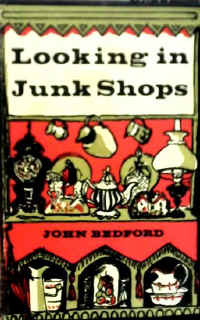
Looking in Junk Shops
Published by Max Parrish, 1961
This book was printed under the pseudonym John Bedford.
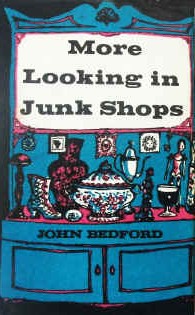
More Looking in Junk Shops
Published by Max Parrish, 1962
This book was printed under the pseudonym John Bedford.

Talking About Teapots
Published by Max Parrish, 1964
This book was printed under the pseudonym John Bedford.

London's Burning
Published by Abelard Schuman, 1966
This book was printed under the pseudonym John Bedford and documents the Great Fire of
London in 1666.
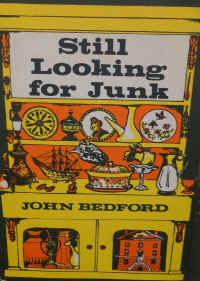
Still Looking for Junk
Published by Macdonald, 1969
This book was printed under the pseudonym John Bedford.
Sources and Acknowledgments:
In the process of compiling this bibliography, as well as referring to my own
collection of literature and the research I have done at the British Library Newspaper
Library, a number of other sources were consulted, not the least of which was Philip
Stephensen-Payne's Galactic Central
website, the home of William G. Contento's Fictionmags Index. A special thank you to John
Herrington for his biographical information on Phyllis Hastings.
Addendum:
Please note that in the Short Stories
section of this webpage, The Evening News and The Star refer to the
London evening newspapers that bore those titles and The Evening Standard to the
London evening newspaper that is still with us today.

Phyllis Hastings in 1951.
A Sketch of the Life and Writing Career of Phyllis Hastings
Phyllis Hastings was the byline used by this author for most of her fiction, with one novel, The Forest of Stone (1957), appearing under the pen name Julia Mayfield. As a novelist, Hastings specialised in historical fiction, with elements of suspense and crime, alongside some early light hearted romances, such as Crowning Glory (1952), which, it must be said, have much humour in them and did not deserve to be tagged as simple romances. Indeed, Hastings, along with her contemporary Ursula Bloom, disliked being categorised as a romantic novelist. This led, in part, to her more serious work and focus on well-researched historical novels which displayed an obvious love of the subject. Most her novels were set in various periods of British history, encompassing the 15th, 16th and 17th centuries through the Victoria era to the early 1900s. Many of them were gothic dramas that often had a countryside setting, although the variety of her subject matter and wide thematic range displayed a remarkable knowledge of many things, such as agricultural life in days gone by and an insight into what motivates rural people who find themselves in trying circumstances. Conflicts within families was a recurring theme, as in Dust is My Pillow (1955), about a family on a Cotswold farm who live under the iron rule of a strict Jehovan patriarch. With beautiful descriptions of nature and strongly drawn characters, this novel led to one reviewer likening it to the works of Thomas Hardy. Her best known novel, Rapture in My Rags (1954), again had a farm as its setting, but is notable for its elements of fantasy and sensitive depiction of an isolated young woman whose passion for what she believes to be a scarecrow that has come to life consumes her.
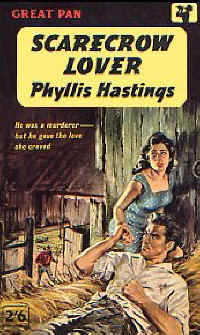
Her trilogy of books about several generations of a Sussex farming family, which began with All Earth to Love (1968), cemented Hastings's reputation in this field of writing, receiving high praise in regional and national newspapers for its authentic description of the countryside in all seasons and the elegance of her prose. Her sense of time and place was remarkable, as was the depth of understanding she had about people and what drives them. Hastings had the ability to tell a great story, the sometimes breathlessly paced plots making her novels real page-turners, but her range of themes and settings was also impressive. The novel The Death-Scented Flower (1977), for example, takes place in 1820, with a handsome young man who works at a horticultural nursery in Wiltshire seduced by a wealthy woman who enlists his services as a gardener—an ulterior motive indeed! What follows is a tale of passion and tragedy with the botanical theme providing a fascinating background. The Field of Roses (1955), one of her first "serious" novels (as was reported in the press at the time), is the story of a young woman who falls for a French hotel owner. The action moves from Bournemouth to France in this entertaining tale, which won her more accolades and is one of the novels which inspired at least one literary critic to compare her work favourably to the writings of Mary Webb. A powerful and moving historical novel, The Overlooker (1982), is set on Dartmoor where the residents fear the investigations of the witch-finder and those working for him in this very dark period of British history. By contrast, The Happy Man (1958), about a party of hoilday-makers staying on a remote island in Italy is notable for its endearing charm and thoughtfulness. There is, at times, a curious mixture of humour and philosophy in her stories. Other settings and themes were explored in novels such as Far From Jupiter (1952), an early romance set on a Pacific island, and Bartholomew Fair (1974), a story about a young woman, Mariana, who is brought up in the world of the travelling fairground and tries to escape the life she was born into. Right across the span of Hastings's career as a novelist, there are over four decades of wonderful writing to be enjoyed. A fine legacy to leave behind. But there were other mediums of writing that she excelled in.

She began writing poems when she was eight years old and went on to have a number of them accepted for publication. A poetic drama based on Greek mythology and written in the blank verse style that Hastings penned as a teenager inspired Sir James Barrie to write her an encouraging letter, which she kept and treasured. At the age of 16, Hastings sold her first published verse work, which was about reincarnation, to John Middleton Murry's The Adelphi. It went on to appear in an early issue of that magazine. Several of her poems were, so I gather, printed under pen names that are unknown to me. The only one I have been able to track down so far in terms of the issue it was published in is "The Lover Praiseth His Lady", which was printed in the July 1946 edition of the British magazine Galaxy, under the Phyllis Hastings byline. Numerous examples of her poetry certainly appeared in other periodicals. Unfortunately, the contents of every issue of, for example, Weldon's Ladies' Journal, have not yet been indexed or digitised online and the same is true for countless British newspapers.
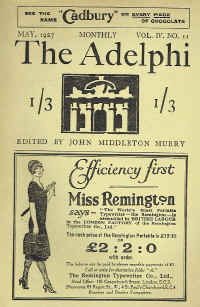
Her short stories tended to be light in tone, with elements of humour and an obvious love of history shining through to complement the sparkling dialogue and the skillfully drawn characters who people her tales. Her range of settings was vast, with stories about Eskimos and gold miners included in her oeuvre, although Hastings never travelled outside Europe. From 1934 until the beginning of the Second World War, over four hundred of her short stories, only a fraction of which I have listed here, appeared in various British and foreign newspapers and magazines. A number of these were also broadcast on radio. "Chameleon", a story that aired on the wireless on June 23, 1946, may well have been written specifically for this medium. Another of her tales for radio was the play "Under the Hammer", which was broadcast in April 1951. Hastings aspired at the time to become a playwright and saw a number of her works produced for radio. Countless other stories appeared in print under four pseudonyms. Several of these were said to have been sold to Thomson-Leng publications, who specialised in women's magazines. As these short stories were printed under unidentified pen names, I fear it may never be known which ones were by her. The bulk of Hastings's short fiction was published in the years leading up to Germany's invasion of Poland, although a handful of her tales appeared in periodicals during the 1940s. In this decade her output lessened, due in part to the war and what she termed "domesticity", with the demands of being a housewife and bringing up a baby son taking up much of Hastings's time. By the end of 1950, after a long spell in this literary form which ended with several stories printed that year in The Sheffield Weekly Telegraph, Hastings had stopped writing short fiction to concentrate on novels.
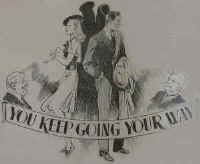
Illustration in Weekly Welcome and Woman's Way
for the short story "You Keep Going Your Way".
Writing as John Bedford, she published several books about perusing junk shops in the search for hidden treasures and exploring the antiques world in general, with volumes on objets d'art, pottery, porcelain and china, etc. Another volume which appeared under the John Bedford pseudonym, London's Burning (1966), examines the Great Fire of London. The list of nonfiction books that I have presented on this webpage does not include all those published under the Bedford name. It would appear that there was an actual John Bedford (1907-1977) who also penned a number of books on antiques. There is no doubt that Hastings did write as John Bedford, but sorting out who wrote what is beyond my capability. There is confusion even within The British Library Catalogue, with some titles having two entries, one credited to the "real" John Bedford and another attributing the same book to Phyllis Hastings! I have included here those books where she has been given credit as the author, but in some cases, I must admit to there being an element of doubt. If anyone has information to share on this subject, I would be pleased to hear from them. My nonfiction books list is, in all probability, not comprehensive and I am not fully convinced that London's Burning was written by her. A number of feature articles were published in British newspapers under the Phyllis Hastings name. The only one I have been able to identify so far is "We Will Have Music ... Wherever We Go!", which appeared in the August 5, 1935 issue of the Birmingham newspaper The Evening Despatch. Going further back in time, two very early examples of her nonfiction were published in the same newspaper. The Evening Despatch ran a competition for readers to submit short essays on the subject of whether the city should make Sundays brighter for residents by opening the cinemas and theatres on that traditionally holy day of the week. Hastings's thoughtful, untitled contribution won first prize and was printed in the January 2, 1930 edition of her local newspaper. A later competition in The Evening Despatch asked readers to send in letters detailing their ideal Christmas party. Although Hastings's piece did not win a prize this time around, her "Away with Scrooge", a concise letter very much in favour of celebrating Christmas at home, appeared in the December 14, 1931 issue.

One of a series of books published by Cassell.
But were they by Phyllis Hastings?
It is pretty well established that Hastings was born Phyllis Dora Hodge on June 5, 1904 in Bristol to Dora Rosina (née Miles) and William Hodge after they were married in 1903. Her father was a well known businessman and freemason. They had another daughter, Barbara Doreen (known as "Bubbles") who was born in 1910. Hastings could trace her West Country heritage as far back as 250 years and took ballet lessons from the age of four, studying under the ballerina Phyllis Bedelis, after whom she was named. Referring to her younger self many years later as "one of those little horrors, a child prodigy," she became proficient enough to pursue a career as a much admired performer, dancing instructor and elocutionist, both in Bristol (in which city she performed at the Theatre Royal, the Coliseum, the Colston Hall and the Victoria Rooms) and later, when at the age of 11 Hastings moved with her parents to Birmingham, where she attended the Edgbaston Church of England College for Girls. By her late teens Hastings was running The Hastings School of Dancing in Handsworth Wood alongside her mother (who as ballet-mistress, went under the name "Madame Hastings"), while writing ballets, plays and revues for the pupils of her academy to perform at shows in Birmingham, with the proceeds given to charitable organisations. One of the most successful of these was "Arabeske", a revue dansant written by Hastings that was performed at the Midland Institute to favourable reviews in the local press. Her success as a dancer led to Hastings being offered a place in Anna Pavlova's dance company, which she declined to accept. Around 1933, when she was still in her late twenties, Hastings gave up both classical and dramatic dancing as well as theatrical work to pursue her ambition to become an author. She had taught herself to read when only three years old, and an early love of literature, it is evident, had sown the seed. It had been, I very much suspect, in the back of her mind since childhood to become a writer and ultimately not continue the career her parents had chosen for her.
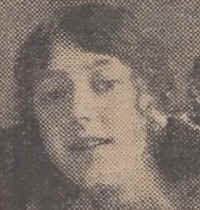
Phyllis Hastings, aged 14.
When it was she changed her surname to Hastings is not known, although as early as her childhood years in Bristol she is referred to in press notices regarding her dance performances in revues (during the First World War, these were often fundraising events that were organised to entertain soldiers on leave) as Phyllis Hastings. This stage name evolved naturally into her writing byline. While living for a brief period in Friars Cliff, Dorset, where she had moved to with her parents some years earlier, she married Philip Norman Spital, an antiques dealer, in August 1938 at the Priory Church in Christchurch. Her bridesmaid was June Druford, an old friend from Birmingham. The newly weds spent their honeymoon touring Scotland by car. After her marriage, she retained the Hastings surname for her literary endeavours. The couple returned to the West Midlands the year they were married, with spells living in Moseley and then Hampton-in-Arden. They had a son, Kerry Hastings-Spital, who was born in Birmingham in 1943. After the end of the Second World War, the family relocated to Peacehaven in 1948, marking a permanent move to East Sussex, which became the setting for several of her novels, such as The Signpost Has Four Arms (1957), about a family snowed in on a farm. She fell in love with the landscape and became a well known local personality in the county. As well as pursuing her writing career, there was a three-year period, starting in 1956, when Hastings ran Lower Steep Farm at Jarvis Brook, near Crowborough, where she had a herd of Jersey cows. The experience of managing a dairy farm undoubtedly inspired her novel Golden Apollo (1958). Hastings and her husband then moved to Court Horeham in Cowbeech. Always an active, hands-on person, during this time, having kept dogs as pets for at least as far back as the 1930s, she tried her hand at breeding Yorkshire Terriers, with unexpected success. One of a litter of four, Vee-Vee was believed to be the smallest dog in the world, weighing just 27 ounces when fully grown. The other puppies were all normal in size, but Vee-Vee was healthy and by no means the runt of the litter, appearing at London's Cruft's Show in 1959. In the same year the couple moved to Mayfield, a village that, no doubt, was the inspiration for the Julia Mayfield pseudonym, which she used for the novel The Forest of Stone (1957), a powerful tale about city life. From the outset they owned an antiques and handicrafts business in the Old Post Office on the high street, a house which dated back to the 1500s. In addition to offering furnishings and interior decoration as part of their service, the couple sold antiquarian books and had a junk shop situated around the corner.

"I'd like to live to be ninety. There is so much I want to do."
- Phyllis Hastings, talking to journalist Marjorie Stannard in 1962.
By 1962, the stress of working in such a demanding trade compelled Hastings to sell the shop, while not fully relinquishing her involvement in the antiques world. Down the years, her possessions included Rudyard Kipling's baby rocking chair and a cedarwood sea chest that had belonged to Sir Walter Raleigh. The latter, after an unsuccessful attempt to sell it at an antiques fair in Cheltenham, failed to fetch its reserve price when auctioned in London at Bonham's in 1975. With some doubting the authenticity of this piece, it attracted no bids. Hastings, meanwhile, was convinced it was genuine, but noted to The Daily Telegraph that it was "not a thing you can absolutely authenticate." It was sold for the reduced price of £1,600 to her son, who had followed in his parents' footsteps by becoming an antiques dealer. He agreed with his mother that thereafter she should keep the sea chest in her study at home. A happier event occurred a few years earlier, in 1970, when she gave a talk at a meeting of the Tunbridge Wells and District Writers' Circle. Her words of encouragement to the assembled authors were appreciated as she pointed out that some of the finest prose writers found success late in life. Giving an insight into her own career, Hastings related the experiences she had during her apprenticeship as an author, the inspiration for her early short stories coming from a study of the dictionary, with words forming the kernel of an idea. Keen to inspire her audience, Hastings declared that "I have more ideas ready to write than I have years left to write them." And in 1972, acknowledgement of her outstanding novels came Hastings's way when it was reported in her local paper, The Sussex Express, that she had been given the honour of being included in the next edition of the Dictionary of International Biography. Hastings went on to receive a Certificate of Merit for services to literature from the Dictionary Committee at an awards ceremony.

The Abbot's Cottage, Battle, East Sussex.
After living in Mayfield for almost two decades, 1977 saw the couple relocate to the 300-year-old Spelland Farmhouse in Broad Oak, near Rye, a venture which turned out to be short lived. By early 1980, Hastings and her husband had settled in a 13th century house in Battle, East Sussex. The cottage itself, a listed building, had been the home of John Hammond, an abbot who resided there after the dissolution of the monasteries during the reign of Henry VIII. The ground floor reception room of the house was turned into an antiquarian bookshop, which she and her husband ran for several years. In addition to being a mother and housewife, running farms, managing an antique shop and writing novels that inspired rave reviews in the local and national press, Hastings had a number of hobbies which included gardening, where she specialised in growing rare trees from seed, painting, studying history, collecting books written for children that dated back to the early 19th century, making clothes, playing the piano and Scrabble. After the death of her husband, Hastings stopped writing and put the Abbot's Cottage up for sale in 1988, although she remained in the area during the final years of her life. It should be noted that online biographical information about this writer is scarce indeed and, at times, erroneous. References to a second marriage, in 1939, to a Thomas Andrews, are incorrect. The date is all wrong, for one thing, being just one year after her marriage to Philip Spital, with whom Hastings remained until his death in 1986. She passed away at Conquest Hospital in Hastings, East Sussex after a short illness, which she dealt with in typically cheerful fashion, at the age of 90 on November 29, 1994. The funeral service took place a week later at Hastings Crematorium. Having achieved so much over the years, I imagine she was particularly pleased to have fulfilled her literary ambitions in such spectacular form. Hastings's many interests were pursued with vigour in a long life well lived.
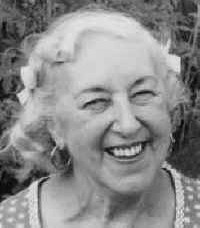
Phyllis Hastings (1904-1994)
Email: marks3789@gmail.com
Copyright © 2025 Richard Simms